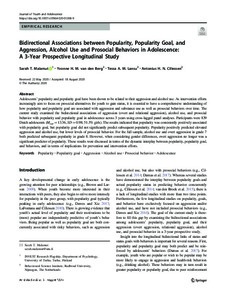Bidirectional Associations between Popularity, Popularity Goal, and Aggression, Alcohol Use and Prosocial Behaviors in Adolescence: A 3-Year Prospective Longitudinal Study
Malamut S. T.; van den Berg Y. H. M.; Lansu T. A. M.; Cillessen A. H. N.
https://urn.fi/URN:NBN:fi-fe2021042824094
Tiivistelmä
Adolescents’ popularity and popularity goal have been shown to be related to their aggression and alcohol use. As intervention efforts increasingly aim to focus on prosocial alternatives for youth to gain status, it is essential to have a comprehensive understanding of how popularity and popularity goal are associated with aggression and substance use as well as prosocial behaviors over time. The current study examined the bidirectional associations of aggression (overt and relational aggression), alcohol use, and prosocial behavior with popularity and popularity goal in adolescence across 3 years using cross-lagged panel analyses. Participants were 839 Dutch adolescents (Mage=13.36, SD=0.98; 51.3% girls). The results indicated that popularity was consistently positively associated with popularity goal, but popularity goal did not significantly predict subsequent popularity. Popularity positively predicted elevated aggression and alcohol use, but lower levels of prosocial behavior. For the full sample, alcohol use and overt aggression in grade 7 both predicted subsequent popularity in grade 8. However, when considering gender differences, overt aggression no longer was a significant predictor of popularity. These results were discussed in terms of the dynamic interplay between popularity, popularity goal, and behaviors, and in terms of implications for prevention and intervention efforts.
Kokoelmat
- Rinnakkaistallenteet [27094]
